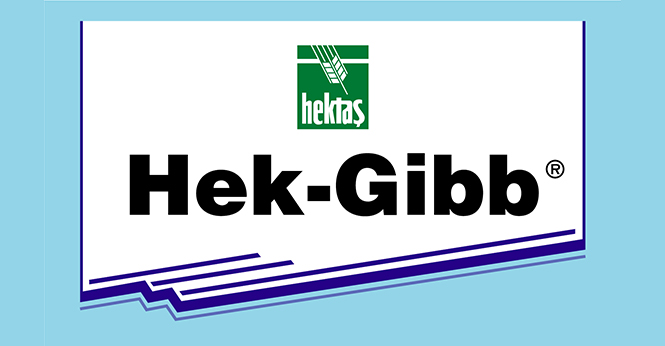
HEK-GİBB®
Active Ingredient: 20 g/l Gibberellic Acid
Formulation : Water soluble concentrate (SL)
Packaging : 20 L, 5 L, 1L, 500 ml
Features
Plant growth regulator containing gibberellic acid in liquid formulation. Spraying or dipping is done according to the place to be applied. Non-alkaline clean water should be used for dilution. When applied to gibberelic plants at the appropriate time, it provides high and quality products.
Method Of Application
The recommended amount of preparation is added to the tank filled to half with water and mixed. After the tank is filled with water, it is mixed again and the solution is made ready.
Miscibility: It is not recommended to be mixed with other products.
Detailed Table Information
| PLANT NAME | FUNCTION | DOSAGE OF USE |
|---|---|---|
| Ornamental plants | It is used in floriculture (Carnation, rose, gladiolus, lisianthus, chrysanthemum) to obtain long stems and large flowers, depending on the species and the growth types of plants. | 200-750 ml/ 100 l water |
| Table seedless grapes | 1st application: Before flowering, when the stems are still 4-8 cm tall, it is used to lengthen the clusters. 2nd application: It is used to dilute the grain during the full flowering period, that is, when 70-80% of the flower petals (flower capsule) are shed. 3rd application: It is used to increase grain size when the grains reach 3 mm diameter after flowering. | 100 ml/100 l water |
| Orange | It is used 4-5 weeks after completion of flowering to prevent June shedding in Jaffa oranges. In Washington Navel, it is used in the period when the color change in the fruits begins to prolong the period of stay of the fruits on the tree and to regulate the harvest. | 100 ml/100 l water |
| Potatoes | Before planting, seed potatoes are dipped in the solution prepared with HEK-GIBB® and planted. Thus, fast and regular output is provided. | 25-50 ml/ 100 l water |
| Lettuce | Used 7-15 days before harvest to promote umbilical cord. | 50-100 ml/ 100 l water |
| Mandarin | It is used in the period when 75-80% of the flowers open in order to reduce the flower drop, increase fruit set and increase yield in Satsuma and Clementine varieties. | 75 ml/100 l water |
| Lemon | It is used to keep the fruits on the tree for 2-3 months in the period when the first color change is seen in the fruits. | 50 ml/100 l water |
| Dried seedless grapes | It is used 4-5 days after the flower capsules are poured to increase the yield and to bring the harvest forward. | 50 ml/100 l water |
| Cherry, Sour Cherry and Peach | It is used in the period when the color change starts in order to delay the harvest and to obtain large and bright grains. An application in the first week of August delays the next year’s flowering by 3-7 days and prevents the peaches from being damaged by late spring frosts. | 75 ml/100 l water |
| Grapefruit | It is used in the period when the first color change is seen in the fruits in order to delay the harvest without rotting, spoiling and softening of the fruit shell. | 50 ml/100 l water |
| Artichoke | It is especially applied to the core of the plants in the period when the plants have 4-5 leaves and the leaf length is 20-30 cm in order to take the harvest forward 1-2 months and to obtain a properly shaped and large head. | 125-150 ml/ 100 l water |
| Strawberry | It is used in nurseries to ensure the reproduction of young shoots given by the rootstock plant and to allow the rootstock plant to lie on the crop when it has 1-6 leaves. It is used 3-4 weeks before flowering to enlarge the fruits and increase the yield. | 75-125 ml/100 l water |
| Pepper | To increase yield, it is used when half of the flowers bear fruit and 2-3 weeks after that. | 150 ml/100 l water |
| Pear | It is used to increase yield in pear cultivars with low fruit set when 30% of the flowers open. | 75-100 ml/100 l water |
| Pear | It is used to ensure the formation of parthenocarp fruit after the frosts that occur at the time of flowering. | 25-100 ml/ 100 l water |
